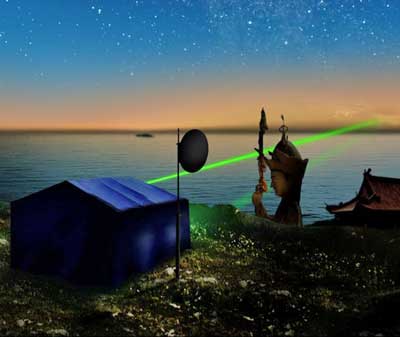|

by Matthew Francis
August 9, 2012
from
Arstechnica Website
It only works at night,
but the technique sets a new distance
record.
Nature,
2012. DOI:
10.1038/nature11332 (About
DOIs).

Photo
illustration of the beacon laser,
used to track an
entangled photon signal across Qinghai Lake.
The statue is
Padmasambhava at the Lotus Temple at Gangcha.
Chang Liu/Jian-Wei Pan
Sending signals through fiber optic cable is reliable and fast, but
because of internal absorption and other effects, they will lose
photons - which is a problem when the number of photons being sent
is small.
This is of particular concern in
quantum
networks, which typically involve a small number of entangled
photons. Direct transmission through free space (vacuum or air)
experiences less photon loss, but it's very difficult to align a
distant receiver perfectly with the transmitter so that photons
arrive at their destination.
A group in China has made significant progress toward solving that
problem, via a high accuracy pointing and tracking system.
Using this method, Juan Yin and
colleagues performed quantum teleportation (copying of a quantum
state) using multiple entangled photons through open air between two
stations 97 kilometers apart across a lake. Additionally, they
demonstrated entanglement between two receivers separated by
101.8km, transmitted by a station on an island roughly halfway
between them.
Though the authors do not make this clear in the paper, their method
is currently limited to nighttime communication.
Nevertheless, their results achieved
larger distances for multi-photon teleportation and three-point
entanglement than before, and the tracking system used may even
enable ground-to-satellite quantum communication - at least if it
happens at night.
Quantum communication requires transmitting an arbitrary quantum
state between two points, similar to how ordinary communication
sends bits (voice or other data) across distances. However, a
quantum state is a small amount of information, typically carried by
a single photon, so many methods used in ordinary communication are
out of the question (including broadcasting).
In fiber optic quantum networks, photon loss is large over
significant distances, requiring the use of
quantum repeaters. Point-to-point
free-space transmission - either open-air or through the vacuum of
space - is better, though larger distances allow the beam of photons
to disperse.
Atmospheric turbulence also contributes
to photon loss in the air, with the losses increasing the farther
the signal must travel.
One of the biggest challenges in point-to-point communication,
however, is target acquisition by the transmitter and/or receiver.
If the ground shifts slightly due to settling or tectonic activity,
or atmospheric turbulence makes the receiver appear to move, the
laser transmitting the signal can miss its target entirely.
With few photons to spare in quantum
communication, real-time tracking and acquisition is necessary. The
researchers solved this problem using beacon lasers, bright beams
that carry no information, but can be used to aim both transmitter
and receiver, and wide-angle cameras.
As usual in quantum entanglement experiments, the group created
entangled photons by stimulating a crystal with ultraviolet light.
This produces a pair of photons with the same wavelength, but
opposite (and unknown) polarization values. These entangled photons
were subsequently sent to detectors, where their polarization
quantum states were measured and compared.
In the first experiment, one photon was
sent 97km across
Qinghai Lake (using a telescope to focus the beam),
while the second was analyzed locally.
Using these photons, the researchers
copied the quantum state from the laboratory to the far station,
achieving quantum teleportation over a much larger distance than
previously obtained.
However, quantum communication sometimes also requires coordination
between two distant receivers, so the researchers set up the
transmitter on an island in the lake. The receivers were 51.2 and
52.2 km from the photon source respectively, on opposite shores of
Qinghai lake, forming a triangle with the transmitter.
The distance between the receivers -
101.8km - was far enough to create a 3 microsecond delay between
measurements of the photon polarization.
Given this setup, there was no possible way for the two receiving
stations to communicate. Yet the photons they registered were
correlated, indicating entanglement was maintained.
These experiments provide not only a proof of principle for
free-space quantum communication, but also a means to test the
foundations of quantum theory over larger distances than before.
With very large detector separation, quantum entanglement
experiments can help differentiate between standard and alternative
interpretations of the quantum theory.
Though the long-distance aspect is promising, the fact that they set
up on the shores of a lake (where no intervening obstacles exist)
and that the experiment could only be performed successfully at
night indicate its limitations.
Author Yuao Chen told Ars via
e-mail that they are working on solving the problem for daytime
communication, but since the signal consists of single photons, it's
not clear how this will work - the number of received photons
fluctuated with the position of the Moon, so noise appeared to be a
significant problem for them.
Point-to-point communication will need
to solve that problem as well before satellite-to-ground quantum
networks are practical.
|

